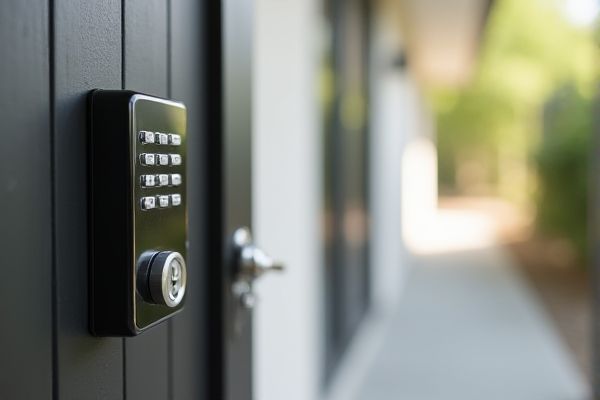
Wireless keypads offer secure, PIN-based access without the need to carry a device, while key fobs provide convenient, quick entry through proximity sensors or buttons. Explore the detailed comparison to discover which option best suits Your security and convenience needs.
Table of Comparison
| Feature | Wireless Keypad | Key Fob |
|---|---|---|
| Primary Use | Enter security code to unlock doors | Remote locking/unlocking with button press |
| Security Level | High - requires PIN code entry | Moderate - uses encrypted signals |
| Ease of Use | Requires manual code input | One-button convenience |
| Power Source | Battery-powered, low consumption | Battery-powered, needs replacement periodically |
| Range | Typically 10-30 feet | Typically 30-100 feet |
| Installation | Wall-mounted near entrance | Portable handheld device |
| Cost | Generally higher due to complexity | Lower to moderate price |
| Common Applications | Home security, commercial access control | Car entry, garage doors, home access |
Introduction to Wireless Keypads and Key Fobs
Wireless keypads and key fobs offer distinct methods for secure access control, utilizing radio frequency technology to communicate with locking systems. Keypads require users to enter a numeric code, providing a code-based security layer, whereas key fobs grant access with the simple press of a button or proximity detection. Your choice between these devices depends on convenience preferences, security needs, and ease of integration with existing systems.
How Wireless Keypads Work
Wireless keypads operate by transmitting encrypted signals to a receiver when you input a numeric code, allowing secure access without physical keys. These devices use radio frequency (RF) communication, typically within ranges of 100 to 300 feet, ensuring reliable connectivity with gate or door control systems. Your access is managed through unique codes programmed into the keypad, enhancing security and eliminating the need for a handheld key fob.
How Key Fobs Operate
Key fobs operate through radio frequency signals that communicate with your vehicle or security system to enable remote locking, unlocking, and ignition functions. These compact devices send encrypted codes to ensure secure, seamless access without physical contact. Unlike wireless keypads, which require code entry, key fobs streamline convenience by offering one-touch control for enhanced security and ease of use.
Security Features: Keypad vs Key Fob
Wireless keypads enhance security by requiring a unique PIN code for entry, reducing the risk of unauthorized access compared to key fobs that rely on proximity signals vulnerable to relay attacks. Key fobs often include encryption and rolling codes to protect against signal interception, but their security depends on the physical presence and battery life. Wireless keypads offer audit trails and customizable access codes, providing better control over user access and monitoring than a typical key fob system.
Installation and Setup Differences
Wireless keypads typically require mounting on a wall and hardwiring or syncing with your security system, offering a fixed access point with more installation steps. Key fobs are compact, battery-powered devices that pair effortlessly via Bluetooth or RF signals, providing portable and hassle-free setup. Your choice depends on whether you prefer a stationary access control method or a convenient, on-the-go solution.
Convenience and Accessibility
Wireless keypads offer enhanced convenience by allowing you to enter a secure code directly, eliminating the need to carry physical devices like key fobs. Key fobs provide quick and effortless access through a simple button press, ideal for hands-free entry in vehicles or buildings. Your choice depends on whether you prioritize code-based entry flexibility or the tactile ease of a remote control.
Compatibility with Modern Security Systems
Wireless keypads offer broad compatibility with modern security systems, supporting multiple user codes and integration with smart home platforms. Key fobs provide quick, on-the-go access but may have limited functionality and fewer customization options compared to wireless keypads. Your choice depends on the level of control and security features required for seamless integration with current technology.
Battery Life and Maintenance
Wireless keypads typically feature rechargeable or replaceable batteries lasting between 6 to 12 months, requiring users to monitor battery status regularly for optimal performance. Key fobs often use coin cell batteries that can last up to 2 years, with minimal maintenance needed due to lower power consumption during passive operation. Both devices benefit from timely battery replacement to ensure uninterrupted access and security functionality.
Cost Comparison: Keypad vs Key Fob
Wireless keypads generally cost more upfront than key fobs due to their integrated touchscreens and enhanced security features. Key fobs remain a budget-friendly option, typically priced lower and providing convenience with simple button access. If you prioritize long-term value and multiple user codes, your investment in a wireless keypad may prove more cost-effective despite the initial price difference.
Which Option Is Best for Your Needs?
Choosing between a wireless keypad and a key fob depends on your security preferences and convenience requirements. A wireless keypad offers keyless entry without the risk of losing a device, ideal for those who prefer to remember a code and manage multiple users easily. Your decision should consider factors like ease of use, security level, and whether you value quick access or enhanced control over entry.
 homyna.com
homyna.com